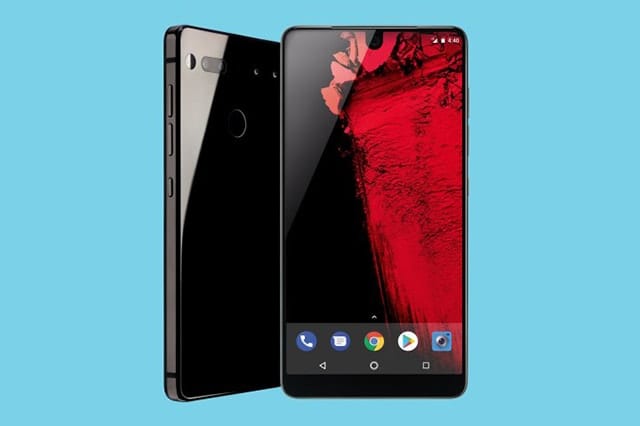A timeless build, promising hardware, and lean interface make this Android phone a head-turner. Is the Essential phone as good as it looks, though?
Potential, versatility, and elegance—the Essential phone does a lot of things right for a first-generation model. And for a market that’s craving anything new, it surprisingly delivers something fresh to the table. The Essential phone, however, is stacked against proven contenders from well-established makers like Apple and Samsung.
How does Essential phone fare against the best on the market? We’ll find out in our review of this promising, new smartphone.
Essential Phone Specifications
The beautifully crafted Essential phone is, frankly, an impressive feat from a brand that has no history of making handsets. A look at its hardware and you’ll see how it’s possible for a first-generation model to turn in a surprising performance.
Dimension | 141.5 x 71.1 x 7.8 mm (size) 185 g (weight) |
Processor | Octa-core (2.45 GHz Quad + 1.9 GHz Quad) 64-bit Qualcomm Snapdragon 835, 10 nm processor |
Screen | 5.71-inch LTPS LCD 2560 x 1312 resolution 503 ppi 19:10 aspect ratio |
Storage Capacity | 128 GB internal storage Doesn’t support MicroSD expansion |
RAM | 4 GB |
OS | Android 7.1.1 Nougat |
Camera | Rear cameras: – Dual 13 MP sensors (RGB + Mono), ƒ/1.85 aperture, Hybrid Auto Focus combing Contrast, Phase Detect and IR Laser Assist Focus Front camera: – 8 MP sensor with ƒ/2.2 aperture |
Battery | Non-removable 3,040 mAh battery Fast charging (wired) No wireless charging |
Water Resistance | Dust and water resistant |
How does Essential’s PH-1 do in key departments?
Design
It’s roughly the same size as Google Pixel XL, but it manages to fit in a 5.7-inch, 2560×1312 screen. All it takes is one look to see why the Essential phone is a feat of engineering.
With that said, Essential takes bezel reduction to a whole, new level with the PH-1. There’s little bezel to see here, so the screen looks like it’ll spill over. As for the front-facing camera, the LCD simply wraps around it instead of shoving it down an awkward corner.
The PH-1 boasts of a titanium frame, too, which is claimed to offer better durability than the aluminum body found on most smartphones with metallic builds. On the outside, the Essential phone is covered in an ultra-glossy ceramic that feels fantastic to hold.
On the edges, one can notice a clever, grippy material. The backside, meanwhile, is outright flat and devoid of any brand markings. In fact, you won’t find an Essential logo anywhere on the phone. Go a little higher to find a fingerprint sensor that’s placed in an optimal area as well as a dual-lens camera, a flash, and the accessory connector ports.
Despite all these positive points, we’re still baffled by Essential excluding a 3.5mm headphone jack. Arguably, that feature right there is still an obvious necessity for many smartphone users at the moment.
Hardware
Any smartphone that calls itself “essential” has to be capable enough to keep up with the rigors of intense, everyday usage. Fortunately, the Essential Phone performs solidly in this department. Built with a powerful engine may have given the phone enough to put forward a superb performance.
Under its hood is a Snapdragon 835 and 4GB RAM so it can easily handle a mix of gaming, casual surfing, music streaming, and some random photo-op with absolute ease. You also get 128GB of internal storage on the Essentials phone. That should offer plenty of memory to work with considering you can’t expand it via microSD card.
On the downside, the speaker may disappoint. It gets really loud, sure, but it doesn’t deliver a pleasant listening experience at its highest levels. And the lack of a headphone jack will dismay, too. Luckily, the USB-C audio experience is surprisingly louder and fuller. Although it doesn’t outclass the performance of dialed-up AMP or a third-party DAC, its quality brings you halfway there.
Performance
With excellent hardware on board the PH-1, an outstanding performance is almost guaranteed for this phone. As a matter of fact, the PH-1 performs as well as bigger smartphones on the market.
With its benchmark scores, the Essential phone performs nearly as good as Samsung’s Galaxy Note 8 and other smartphones with the Snapdragon 835 processor. That’s surprising since it doesn’t have 6GB RAM as most of its immediate flagship competitors do.
When used with the usual, everyday workload, the PH-1 performs without any noticeable hiccups.
We’re a little disappointed that it isn’t built with the robust OLED display, though.
Interface
This aspect of the phone is where it gets a little divisive for most users. While Android purists will praise the fact that the PH-1 comes with a stock Android Nougat 7.1.1, the lack of any useful bloatware will probably turn off casual users.
If you like the simplicity of a Pixel phone’s OS, you’ll probably like the same bare interface on the PH-1.
You’ll waste little time removing pre-installed apps that other manufacturers bake into their own Android skins, after all. This gives you enough freedom to create a truly personalized library of apps.
When you’ve grown fond of the little extras other Android phone manufacturers include in their handsets, the Essential phone’s software may feel like an uncharted terrain to you. You may have to live with a lack of additional gestures, night mode setting, or extra keyboard UI that are baked into other custom Android interfaces.
You get nothing but bare essential apps (courtesy of Google) right out of the box with the PH-1.
Camera
Plenty of today’s flagships have jumped on the dual-camera bandwagon, for good reason. The PH-1 clearly didn’t want to be left behind. Each of its rear lenses is 13MP, where one is a dedicated monochrome lens and the other shoots in color and black-and-white. It’s selfie cam, meanwhile, is an 8MP shooter that is capable of 4K video recording.
Although most shots you take from the Essential phone will do just fine, it may not be as pretty as the ones you take on the Galaxy Note8 or Google Pixels. Its camera also has a glaring problem: camera software processing. Not only does it take too long to boot the camera app, but it’s also a little slow capturing photo.
Its barebones camera app gets frequent updates, though, and it has certainly gotten better with its file and shutter speeds. The update even added an HDR mode. Still, the PH-1 stutters when changing between lenses and focusing on the subject.
Battery
The Essential PH-1 comes with a respectable 3,040mAh battery. Seems a little small at first glance, but the phone surprisingly lasts all day long just fine. Overall, its discharge rate is fairly typical and it can easily withstand a day of various multimedia demands.
The narrative changes almost immediately when you bring in its accessories, though. Use its 360-degree camera accessory and you may notice it zapping the battery to the point of overheating.
On the plus side, it helps that the PH-1 powers up in a jiffy. All it takes is 10 minutes to get it back to 15% and another hour to reach 85%. Taking an hour and a half to get a full charge doesn’t seem too bad, at all.
Is PH-1 a Worthy Buy?
Essential’s PH-1 phone has a solid grasp on the bare essentials that one expects from a flagship Android phone. It’s elegantly designed, crams so much promising hardware, and runs with a clean interface. While it impresses in many ways, it suffers from a few setbacks as well. Being a first-generation model means that the phone’s few letdowns will only improve from here on, though.
Overall, it’s a solid choice for an Android smartphone that anyone with an eye for design will definitely love.


